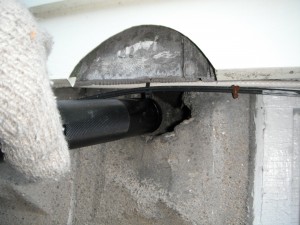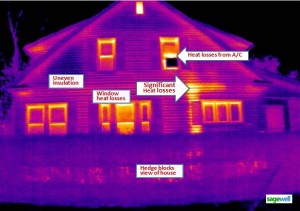
That is a large, D-cell sized flashlight being eaten by a hole for a 1" electrical line. (see note)
It seems just about everybody (except me) was on vacation last week. I hope wherever your travels took you that you enjoyed some well-deserved rest.
Now that you’re back, what better way to relive the vacation than to help make a neighbor’s home more energy efficient? (How’s that for a segue?) Some work will allow you to enjoy the great outdoors, some will put you in the comfort of the home, and others will have you imagining, but not actually drinking, tropical fruity drinks.
One bonus of this home is that we are NOT working in a sweltering attic – she recently had (at A-HEET’s suggestion) insulation added and took advantage of rebates, making work in the attic unnecessary. We’re now doing a lot of other things to seal the home up tight so it stays warmer in the winter and cooler in the summer.
Things like:
- Weatherstripping doors
- Caulking around windows
- Finding and sealing those random “what’s up with that?†holes
- Installing rigid insulation under an addition (enjoy the great outdoors!)
- And many other jobs that most homes need, and most homeowners can do themselves with a little training.
Please RSVP by contacting us via email: arlheet@gmail.com
note: That image was taken this winter at the home we’ll be working at Sunday. Cold, and mice, were getting into the home. This certainly isn’t the only hole mice could get through, but after sealing it that cold day no mice have returned, as per the homeowner.




